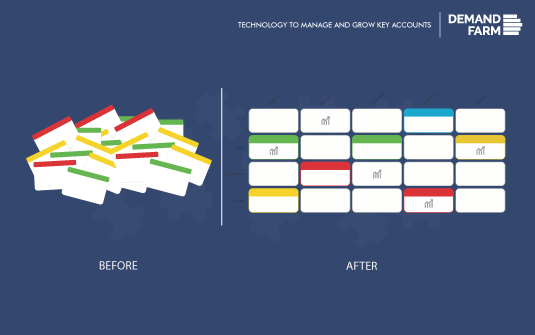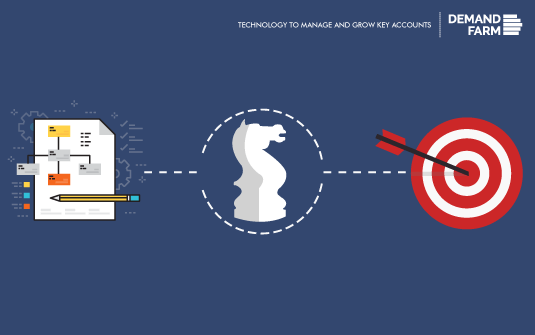Sales Playbooks for Key Account Management – Everything You Need to Know

All salespeople dream of rolling out strategies that run high on the ‘leads’ factor. But sales is not just about sustainable leads – it is about engaging with your audience and translating the brand’s offerings into tangible solutions to convert them into ideal customers. But how can you do that effectively without resorting to trial-and-error for every customer? This is where a sales playbook comes in. A sales playbook is a how-to guide that puts the correct strategy and tools at salespeople’s fingertips to maneuver every sales cycle stage skillfully. It walks your sales personnel through commonly-encountered scenarios, including prospecting and nurturing leads, when to sell what product or service, dealing with different types of audiences, and more. If understanding what a sales playbook comprises can be a head-scratcher at times, what with its many elements, knowing how to make it work for Key Accounts is doubly tough. Nevertheless, employing a playbook polished by their sales experts unsurprisingly gives companies an edge. However, rote observance of processes that may have gone out of date can stall, if not seriously impede, this growth. Unfortunately, even as fledgling digital applications gained traction within most business departments in the 2000s, many companies failed to leverage technologies to their full extent for sales. Adapting Sales Playbooks for the Digital Selling Age Two recent phenomena have turned this attitude on its head. First, ubiquitous digital interactions — that have reshaped the customer journey and, subsequently, the sales process. Second, the onset of the pandemic and the massive shift to remote work, which has forced sales personnel to navigate their business relationships online and, often, individually. This makes the sales process a bit tricky, especially when you consider the high customer expectations most key account leads harbor. Today, every employee reflects the company, and salespeople more so, for being the company’s first representatives. A consistent and uniform approach while mostly working separately can be difficult to accomplish if mishandled. This is where the digitization of processes can help. If incorporated smartly and appropriately, it can help companies capture and retain strategic accounts. For example, DemandFarm’s Org Chart digitizes an organization’s existing internal hierarchy, relationships, influence, and decision power (read more on this in the next section). All this and more deliver the following key benefits: Ease of Transfer: It is important for sales reps to have a connected view of data, and digitization enables the entire sales pipeline to be transparent to all team members. This means that if a salesperson is unable to entertain their prospective key client, anyone else from the team can take over with ease. Analytics Management: With every piece of information online, monitoring performance indicators, generating reports, and analyzing customer data to improve pitch and process is effortless. Better Process Efficiency: Complex internal processes increase the burden on sales reps. Digitization can mitigate this by facilitating sales teams to use less time and effort and fewer resources to do the same work, equipping them with more efficient processes. While the advantages of digitizing your sales playbook to manage your key accounts are clear, is it possible to do so without disrupting operations? Cue in sales tools for the digital world. Role of Digital Tools to Make This Easy To circumvent possible rejection of your transformed sales playbook, you must ensure two things before zeroing in on any tool. Understand the needs of your business: With more than a thousand vendors in the sales tech arena, there is no dearth of tools. However, it is important to understand which of these tools is ideal for your business requirements lest your investment goes to waste. Involve Your Team: Before deciding on the tool, talk to your team members about the issues they face and invite suggestions for possible solutions. Your sales team needs to be comfortable with your chosen tool to employ it efficiently. Components of an Ideal Sales Playbook in KAM Now that you’ve got a good idea of what to do before selecting your ideal tool, let’s go over the types of sales tools available to you for key account management. Sales Intelligence Sales intelligence involves analyzing data and using it to create insightful reports and estimate future performance. Whether it be sales performance reports or productivity logs or analytics on strategic account behavior, sales intelligence, as a function, takes charge of all data extraction and scrutinization. Relationship Intelligence is a crucial part of any Sales Intelligence process as it helps to map all the relationships and interactions among the teams of customers, both current and potential. It indicates the nature of each entity’s connections and influence on others. Relationship Mapping is important for any Sales Intelligence process because: It helps to gain insights into the relationship, no matter whether it be in terms of age, tenure, seniority, or any other factor. It is useful when trying to understand the growth rate of an organization, which can be achieved by examining the number and nature of relationships in the company. It is integral to any sales process, especially in business-to-business (B2B) companies. This is because the company’s growth is usually dependent on the growth of its relationships and how its team locks down key deals. Sales Enablement As the name suggests, sales enablement empowers salespersons with the resources they need to prospect, close, and nurture leads. This is facilitated by analyzing the data from the marketing, content, and sales departments and drawing on it to align the three cycles, consequently enabling sales personnel to close deals. Benefits of Sales Enablement include: Salespersons can effectively capture key accounts by streamlining communication between departments and providing resources like content and information. The sales team can be better prepared and equipped for upcoming meetings and presentations. Advanced analytics helps companies to understand the current state of their sales cycle, allowing them to identify areas of improvement and highlight the highest-value opportunities. Sales playbooks are an effective way of organizing both your sales enablement and relationship intelligence data into one place. You can read
Account Management 101 – A Complete Guide for Key Account Managers

Account Management: A Comprehensive Guide Account management is the process of building and nurturing strong relationships with key customers to drive growth and revenue for a business. It’s all about understanding your clients’ needs, providing exceptional service, and creating value that keeps them returning. Account Management is all about identifying and focusing on your top 20% of accounts, which have the potential to drive 80% of your revenue while being a trusted partner/advisor to them. As a trusted partner or advisor, you’re not just there to sell them your products or services; you’re there to help them achieve their business goals and overcome their challenges. Hence, getting to know your clients and their businesses is crucial to anticipating their needs and proactively offering solutions that make their lives easier. A study by Global Partners Training found that 61% of companies reported that strategic account management or key account management programs helped them increase their revenue and customer satisfaction. Account management is about being a trusted partner who helps your clients succeed. This comprehensive ‘Account Management 101’ guide explores the fundamentals of account management, the importance and key responsibilities of account managers, and account management best practices. Continue reading. Download: White Space Analysis Template to Unlock Key Account Growth Definition: What is Account Management? Account management is all about nurturing strong, long-lasting relationships with your key customer accounts. It’s not just a one-time transaction; it’s a continuous process of managing and strengthening those crucial client partnerships throughout their journey with your business. The role of an account manager is like being a trusted advisor to your most valuable accounts. They oversee the sales process, making sure things run smoothly from start to finish. But it’s not just about closing the deal. To understand Account Management better, here is an example of Jane. Jane is an account manager at an organization that offers a CRM solution. Her first task is guiding her customer – a retail chain smoothly through the sales process – coordinating meetings, demos, negotiations, and everything required to close the deal successfully. But her work doesn’t stop there. Once the contract is signed, Jane starts planning for the long term. She develops a strategy to ensure a seamless rollout and implementation of the new CRM across all the client’s store locations. She coordinates training sessions for the end users and schedules regular check-ins to gather feedback. Account managers are also responsible for planning and ensuring there’s a solid strategy in place to maintain business continuity with your customer base. Part of their job description is being on the lookout for opportunities to offer additional products or services that could benefit the customer – that’s what we call cross-selling and up-selling. As the partnership progresses, Jane is always on the lookout for opportunities to offer additional solutions. Maybe the client could benefit from an advanced analytics module to better understand their retail customer behavior. Or perhaps they need a custom integration to sync the CRM with their inventory management system or other tools in stack. Jane suggests these cross-sell and up-sell options when appropriate. The goal here is to maximize client retention and growth by really catering to customers’ needs. But account management isn’t just about keeping your best clients. The ones who have been with you from the start and played a role in your company’s success story? Those clients are invaluable assets to your organization. Developing a winning relationship with them is the secret ingredient for businesses of all kinds. Evaluate Now: Key Account Management Maturity Modelling Guide What is the importance and the role of account management? The key thing to understand about account management is that it’s all about the long game. As expert Olivier Riviere put it, true strategic accounts aren’t just big spenders – they have special meaning for growing your business over time. You need to know which accounts have that lasting potential. Account management is a continuous process of nurturing relationships, not a one-off sales transaction. It takes consistent time, effort, and investment to manage those accounts well. But make no mistake – even long-term clients could leave anytime for a competitor if you don’t give them the service they deserve. It is a long and cyclic process that takes time, effort, and money. However, those key accounts are likely to churn anytime or be snatched by your competitors. The client who has been with you for years would be a vital lead for your competitors. Hence, the chance of losing them can be detrimental for your business. A good account management strategy can prevent it. Must Watch: Liangbi David Shen, Head of Revenue Operations at Cambridge Mobile Telematics sharing their experience around building processes & strategies for Account Management. Account Management vs Sales – What’s the difference? In simple words, Sales focuses on winning new customers and net-new revenue, whereas account management recognizes existing key customers and nurtures long-term relationships with them while expanding revenue. Say you run a consumer electronics business. Your sales team focuses on promotions and discounts to offload inventory – they’re all about meeting this month’s numbers. In and out transactions. An account manager, on the other hand, might cultivate a partnership with a major retailer for years. They’d coordinate product launches, train retail assistants, and provide reporting tools – whatever that key account needs to keep doing business with you long-term and grow over time. It comes down to sales accelerating immediate numbers versus account management planning future growth by adding value to key accounts. And make no mistake – landing and retaining those high-lifetime-value accounts takes strategy and resources. Likewise, account management finds the scope for future benefits rather than the benefit of a one-time deal. Not surprisingly, the art of account management and identifying key accounts is a complex process. You have to carry out a broad business prospect to afford and manage such accounts because they are going to benefit from your time and effort in the long
How Key Account Management solutions help make sales teams more efficient | DemandFarm at DeepTech Innovation Week

Effective key account management requires you to increase profits, develop relationships, increase satisfaction, grow revenue, improve retention and reduce conflict. It’s a big, complex job and organizations need to invest more in the right technology to help account managers be more effective. Existing customers are a critical revenue source for almost every organization. Meeting organizational growth targets requires sales leaders to establish well-defined account management processes and tools that retain customers and enable account teams to identify, develop, and execute growth opportunities within their account bas
Powering Sales Intelligence in KAM to Drive More Leads

“There was once a factory that was run by a large engine at its core. One fine day the engine broke, shutting down the entire operation. After several engineers failed to solve the problem, the factory owner approached a veteran engine expert as a last-ditch effort. The expert inspected the engine for a whole hour, pulled out a hammer from his toolkit, placed it above a specific spot, and tapped once with panache. The engine roared and started working again at once. The owner, ecstatic at the result, thanked him and inquired about the fees. The expert handed him an invoice for $10,000. Angry at the ‘atrocious’ amount, the owner exclaimed, “You hardly did anything! $10,000 for a single tap? I want to see an itemized bill.” Without saying anything, the expert simply made another invoice that read: Tapping with a hammer: $2 Knowing where to tap: $9,998” Every time I think or read about Automated Sales Intelligence, it reminds me of this story. As sales leaders, we come across such scenarios every day. Whether it is about finding qualified leads, pushing customers through their buyer journeys, or boosting the conversion with landing pages, every information about the customer helps to ‘place the hammer’ at the right spot for the ‘decisive tap’. Today’s blog delves into what automated sales intelligence is, how to gather sales intelligence effectively, and how integrating CRM with sales prospecting intelligence can transform your sales engine. What is Automated Sales Intelligence? Automated sales intelligence refers to the technology and processes that empower sales teams to gather, analyze, and leverage substantial amounts of data about prospects and existing customers. This intelligent approach allows sales professionals to derive actionable sales intelligence that enhances their decision-making capabilities. This helps sales leaders and teams to: Track key changes and information bytes of existing accounts Map key stakeholders in prospective organizations Understand the needs and wants of prospects Collate and index real-time company information And much more… Sales Intelligence = Intelligent Prospecting When done right, Sales Intelligence is all about selling hard and more in the least possible time. Naturally, the benefits extend to a crucial arm of the new-age sales process – Prospecting. By overhauling prospecting and equipping it with ‘Intelligence Data’, Sales Intelligence tells salespeople who they should be talking to, the precise conversations that they should be driving, ideal times at which they should be reaching out to prospects, and more. Ideal Sales Intelligence tools also go to the extent of eliminating manual processes of scraping for critical insights, verifying for their authenticity, and providing a 360-degree view of the prospect. Such benefits have been driving the adoption of Sales Excellence to the point of no return. As per a report from GrandViewResearch, this has witnessed the global market to be valued at $2.29 Billion in 2019 with the expected CAGR to be 10.5% from 2020 to 2027. For instance, consider a scenario where a salesperson is in charge of generating new leads. She is armed with a list of ‘potential’ prospects and the blueprint criteria of what the company’s ideal customer profile stands as. By feeding such data into a Sales Intelligence tool, she can be instantly notified when any new company falls under the purview of the ideal customer profile. And all this without the customary stalking behavior that we usually exhibit as salespeople! Importance of Data in Sales Intelligence As you may have caught up by now, data naturally plays a central role here. But long and complex sales cycles often need much more than numbers and addresses. And as reported by Salespanel, most sales intelligence platforms focus on providing intent data. This usually includes key behavioral information about the prospect’s digital activities. Sales are all about making the right decisions at the most ideal times, a natural habitat for data to thrive in. But while the quantity of data matters here, so does the accuracy. With hyper-contextual marketing and sales data, sales intelligence can drive successful relationship-building that focuses on the correct conversion or engagement parameters. And that’s not all. Sales Intelligence also seeps into the foundation by transforming how customer profiles are shaped. Hunches, feelings, and opinions are categorically eliminated and all intelligence is driven by a consistent profile that does not deviate from one leader or department to another. Such a stable approach keeps every stakeholder on the same page and channels sales and marketing efforts in the right direction. How Sales Intelligence Affects: Data Quality and Management Poor sales data is one of the foremost challenges that salespeople face. Sales Intelligence places immense focus on assessing data quality and improving it with a data quality strategy that brings positive ROI. Key metrics that are usually leveraged here include: Email Bounce Rates: The number of emails that go undelivered due to bounce backs directly correlates with the health of your sales data. The ratio of Data to Errors: Tracking redundant, missing, or incomplete data entities that are depleting data quality. Improved data health here translates to fewer errors with constant or growing data size. The number of Empty Values: Corresponds to missing information or data that has been entered incorrectly into a field. Keeping a track of empty fields and how this number changes over time is a characteristic of sales intelligence. Data Transformation Error Rates: Converting existing data into a different format can introduce another class of errors. As a sales intelligence metric, it becomes important to keep track of data transformation tasks that fail. Quantity of Dark Data: Dark data refers to complicated data quality issues that may not be resolved easily. They are best resolved with elimination and require close monitoring. Data Storage Costs: If the amount of data that you are leveraging in sales remains constant but the storage costs are rising, it can be a sign of poor quality issues. Data Time-to-Value: Another way to measure quality is the time it takes for salespeople to derive actionable value from a given data set.
Sales Transformation in Key Account Management

It was the year 2015 and Coca-Cola was sitting on a goldmine of an ever-growing customer database. The roadmap ahead was clear – to boost the consumption of their existing line of products through sales transformation. Because we are talking about one of the most recognizable brands in the world, this was no easy feat. With a thirst-quenching range of 500+ beverages, over 1.9 billion servings of Coca-Cola products are consumed every day! As expected of any global brand, they led a graceful response. They placed data at the heart of their sales transformation journey by listening to customer opinions over the phone, email, and social media. The next step was to curate targeted content for different audiences that aligned with their passions. The result? Consumers are 4 times more likely to click on their digital adverts (according to Bernard Marr & Co.). If there is one idiom that can accurately sum up the entire digital age, it is this – using data to learn about customer behaviors and point them towards relevant conversions. That’s what every innovation on the planet is about – to be a relevant building block towards making the ultimate sale. And as it turns out, data has always been the missing ingredient when it comes to Sales Transformation in the digital era. What is Sales Transformation? Sales transformation is the process of aligning every cog in the wheel of driving the growth of an organization. At its core, sales transformation is about implementing big ideas and the shift in sales focus that is required to deliver the target results. It is as much about the “change” in sales techniques and skills as it is about making that change stick. With that being said, the end goal of sales transformation is to make the change in behavior, skills, and results measurable. For instance, let’s say that a business is targeting to close more deals this quarter than the last. As the leader, your goal would be to revamp the current operations and processes of the sales team and provide them with the required tools and frameworks to meet the new sales targets. Importance of Strategic Sales in Key Account Management There is no denying the fact that growth in Key Account Management is closely tied to the ability to drive the execution of sales strategies. This is a deciding factor that can make or break the reputation of organizations, and even sales leaders. Richardson reports that the average tenure of a sales leader lies between just 18 to 24 months! This is an alarming statistic and only accentuates the importance of a coherent sales transformation strategy. In Key Account Management, the criticality is at another level altogether. Not only do sales leaders need to meet short-term business objectives, but they also need to ensure the long-term viability of the entire business development vertical. For instance, if an organization is launching a line of key services to capture a bigger piece of the market share from their competitors, the value of stakeholders can only be driven in the long term if the sales strategy is updated and redefined according to the new targets. Looking Past Traditional Account Management Strategies As a sales leader, being adept at new-age account management strategies would make you realize that traditional account management can cause more harm than good. To meet the growth targets in today’s digital landscape, account teams need to pinpoint, hand-hold, develop, execute, and deliver on every growth opportunity. This is especially the case if such opportunities are the side-effect of a well-defined Land and Expand ideology. With a traditional backdrop, account management channels tend to perform much below their full potential with cross-selling and upselling initiatives falling short of the intended growth targets. This is backed by key reports from Gartner. Source – Gartner.com Therefore, there is direct and clear potential for cross-selling and portfolio expansion. This is primarily due to the evolving nature of the job of account managers who are now expected, more than ever, to deliver services, resolve issues, and maximize ROI while also driving the exposure and conversions of new services or products. Driving sales growth now requires a rather fundamental shift in skill sets and on-the-job attitude. And this is exactly where the need to explore new models of account growth comes into the picture with ‘customer improvement’ at the helm. Source – Gartner.com Such a shift would involve leaving behind product success and service and instead implement tactics such as: Finding and simplifying the process of identifying opportunities for customer improvement within key accounts. Measuring the effectiveness of sales strategies and tracking the potential of key account growth. Delivering customer improvement via growth-oriented account teams. Clearly defining the roles and responsibilities of every team member. Key Elements of Sales Transformation To drive effective sales transformation, you need to relook at your key accounts as solutions, rather than mere transactions. To implement this, 6 key ingredients can function as perfect fodder: Employee engagement: Focusing on boosting employee engagement and retention to create a strong internal team and culture that is hell-bent on driving customer success. With a team of better-motivated employees, the path to sales excellence becomes easier and shorter to achieve. Cross-functional collaboration: Key account management teams that work closely together even when assigned to different roles or cases. With dedicated cross-functional Account Management KPIs that are tied to each other, personalized support can be driven for every use case of cross-selling/up-selling. Capability building: Regularly helping the sales teams to up-skill themselves to create employees that are highly engaged and in-tune with experiential and war-room sales strategies can be a trigger for sales acceleration. The end goal is to create a motivated sales team that can deliver impeccable and memorable customer experiences. Digital transformation: With the ever-changing digital landscape, customer expectations are constantly evolving with a never-ending work of bridging the gap between their wants and the ground reality of implementation. Effectively managing such expectations with a bull’s eye digital transformation
Customer Success and Key Account Management: 2 Intricate Cogs of the Same Wheel

When Jeff Bezos founded Amazon in 1994, he did so with the mission of becoming “Earth’s Most Customer-Centric Company. ”Fast-forward to 2020 and one can argue that customer success, and rather customer obsession is the sole pillar that Bezos’ entire $1.7 Trillion empire rests upon. But while the vision during the early days was in place, the definition was nowhere in sight. As Bill Price, former Global VP of Customer Service Amazon explains, Bezos interestingly (and maybe even purposely) resisted accurately define his vision for several years. Eventually, things took shape and Bezos took the first major decision that would drive his point home – allowing customers to review the products – a decision that attracted strong initial backlash owing to possible sales detraction. But Bezos was firm in this belief – “We don’t make money when we sell things. We make money when we help customers make purchase decisions. “Over the decades, this vision has transformed into a near maniacal culture of customer success, one in which Bezos leaves a chair empty at conference tables as a reflection that it has been occupied by the customer – “the most important person in the room”. Today’s blog is a journey into customer success, the benefits that it can reap for your organization, and what it looks like in practice! What is Customer Success All About? In essence, customer success is about making your organization’s culture, philosophy, department, or role all about the customer. And especially in a manner that your customers can easily find ‘success’ with your products and services. When customers interact with a brand, they expect a specific desired outcome via an experience that can be tagged as ‘meaningful’. Customer success is about meeting such expectations time and again. As Jeff Gardner puts it – “The fastest you can help customers understand and extract value from your product that is in line with their business goals, the stickier and more successful they’ll be.” Misconceptions About Customer Success Since customer success is a rather newer concept in the management world, a lot of misconceptions exist, especially when managers deploy customer success programs for the first time. Myth 1: Customer Success Always Translates to Hands-on Service Customer success might translate to being obsessed with customers. But this does not necessarily mean that CSMs are engaging with customers round-the-clock. Customers prefer minimal interactions and the fewest possible touchpoints for their queries to be addressed. Hence, customer success, in this case, would mean optimizing such touchpoints for smoother onboarding, documentation, automation, etc. Myth 2: Customer success is a single department drive This cannot be farther from the truth. While it is true that customer success cannot thrive without ownership, it has to be a pan-organization effort. Assigning customer success to specialists is just the tip of the iceberg and would amount to nothing if the rest of the organization does not follow suit and work collaboratively towards a single objective. Myth 3. Customer success translates to feedback collection and analysis Don’t get me wrong. Feedback is one of the most crucial building blocks of customer success. But assuming that customer success is only about customer satisfaction surveys and Net Promoter Scores is highly erroneous. Surveys might be good for specific queries, but they lack in-depth insights about products, customer behaviors, trends, correlations, and more. Why Does Every Business Need Customer Success? “Until you know what it takes to achieve success from your customers’ perspective you will just waste valuable time.” – Jason Whitehead, Tri Tons Your business’s success closely depends on the success of your customers. That is the crux of this blog. There is no point in selling a product or service if your customers are not “winning” (constantly) after making their purchase decisions. Jeff Bezos is a billionaire NOT because he has created an automated sales ecosystem. It’s because he has created thousands of millionaires around the world through Amazon in the form of star sellers. It is also because Amazon helps end customers to make the best purchase decisions for their available budgets. If that’s not convincing enough, here’s why customer success should be at the helm of your business strategy in 2021: Reduces Churn: When you listen to your customers and accordingly iterate your service or product, it’s only natural for their satisfaction graph to rise and for them to stick around longer. At a proactive level, this also translates to solving issues of customers even before they can spot them! Drives Revenue: It should not come as a surprise that the majority of your revenue comes from (or should) post-sales relationship building. That’s simply because it is much easier and economical to up-sell and cross-sell instead of acquiring new ones! Improves the Renewal Process: For businesses functioning on SaaS and subscription models, renewal conversations and decision-making on the part of their customers are fairly common. With customer success, users are more likely to keep renewing and stop questioning their decisions time and again. Customer Success in Key Account Management If customer success is all about aligning the definition of success of clients with your organization, then how does Key Account Management (KAM) come into the picture? In essence, KAM is a subset of Customer Success. Think about it. If 80% of your revenues come from 20% of your clientele, customer success would translate to successful KAM for these accounts simply because they matter the most. To achieve the best results, you must merge the two management styles to ensure the most optimal outcomes for your business. During implementation, this is not a complex feat to achieve since KAM and CS are two sides of the same coin. This also brings us to their key differences: Client Focus: In a typical Customer Success scenario, you would not want any client to be left behind. The idea is to help each one of them succeed to the point of no return. On the other hand, KAM expects you to cherry-pick the clients that add the most to your
Everything You Should Know About Account Management KPIs

Jose Mourinho is quite a peculiar figure in the world of football. Our story unfolds in the Champions League semi-final match between Inter Milan and Barcelona in 2010, arguably the biggest competition in football. Inter Milan, managed by Jose at the time, was set to host Barcelona, a team that was (and is) known for its quick and accurate ball-passing prowess. To make things worse for their opponents, Barcelona also has the most lethal football player today – Lionel Messi. With a much weaker squad on paper, Jose had to pull off an audacious stunt to win. And, rather unexpectedly, he did. One of his primary tactics was to not cut or water the grass at the Inter Milan ground for weeks (a screwed tactic that he used again while at Real Madrid). This took the Barcelona players by surprise and affected one key metric that dictates their signature playing style – pass success rate. The result? Barcelona lost the match 3-1, and Inter Milan went on to win the competition. An obsessive focus on just one key performance metric was enough to stifle the best team in the world at the time. That is the power of KPIs. If understood well, they can be shrewdly used in any field, including key account management, to turn the tide from a bird’s eye perspective. This blog takes a look at how you can do the same for your key accounts and scale them by encouraging the right management behaviors. Account Management KPIs What are Account Management KPIs? Account management KPIs, or key performance indicators, are metrics monitored by account management teams for both internal assessment and external performance evaluations. They serve as benchmarks to gauge effectiveness within specific areas of the company, similar to how marketing KPIs analyze the efficacy of various marketing campaign components. Setting Powerful Key Account Management Objectives Starting any business is easier than scaling it. That’s the first axiom in the corporate world. However, with key account management, challenges can be particularly complex. With a lot of strategic moving parts, such as Land and Expand, it is important to clearly define and lay the foundations of powerful account management objectives to steer the ship in the right direction and deliver the desired results. More often than not, establishing the right mindset is a precursor, and the biggest challenge, to selecting ideal account management KPIs. And this also brings us to a major pitfall in this domain – focusing on too much too soon. This reminds me of an Aphorism by Nassim Taleb from The Bed of Procrustes- “They think that intelligence is about noticing things that are relevant; in a complex world, intelligence consists of ignoring things that are irrelevant.” The best account management growth strategies are the ones that are the most simple. Most accounts should consist of only a few impactful components that set you apart from your competitors. And by natural extension, this means focusing on only a handful of impactful KPIs rather than the opposite. KAM Glossary: Crucial Account Management Terms Explained The Importance of Generic KPIs Our notion of simplistic account management philosophy also extends to selecting generic KPIs to determine the performance of departments. Surprisingly, most leaders often focus on specific KPIs while making decisions, failing to realize that the specificity of the KPI itself takes them away from the big picture! For instance, imagine a Key account manager focusing on the expansion rate of a couple of accounts to assess his performance, failing to make note of the high churn rate of his entire portfolio. Any decision made in such a scenario would be biased and would overlook the true picture. Aligning Key Performance Indicators for KAM Okay, so you have your account management objectives in place and are ready to dig into some quality generic KPIs to build a solid foundation for account expansion. But another challenge crops up – an account management KPI that is fit for one department may not be so for another. It might also be the case that the incentives of your account managers depend on multiple KPIs. How do you then align various KPIs together to reach the desired results? By constantly iterating your account plans, as explained by Calin Muresan, Business Manager at Netguru. More than a blueprint for your teams, account plans should be looked at as frameworks to deliver results for your clients. By constantly finding KPIs that are dependent on each other and iterating account plans accordingly, leaders can keep the roles and responsibilities of account managers and ensure that KPIs are aligned in terms of: Strategic Direction Business Processes Business Units For example, consider that an account plan has the objective “Increase customer satisfaction”. To measure this, the management might have the option of two KPIs – %age Customers satisfied or Customer satisfaction index. Now if ‘Expenses incurred in account operations’ is another KPI to be minimized, selecting the correct option of the two would consider the budget allotted for KPI activation. As a general rule, it should also be noted here that the efforts or expenses that go into measuring the KPI for key account management should not be greater than the benefits that are realized as a result. 11 Crucial Account Management KPIs that dictate Success With the foundational jargon and mindset in place, let’s now take a look at the top Account Management KPIs (generic or otherwise) that account managers must focus on for long-term success. 1. Unlocking Key Account Success: Understanding Customer Lifetime Value and Its Strategic Impact Customer Lifetime Value is a metric that can single-handedly dictate the success of any key account, which denotes the total revenue that a business can generate from a single account in the entire course of the arrangement. It is calculated by: Customer Lifetime Value = (Customer Value) x (Average Customer Lifespan) Why is it important? Because it instantly tells you about your most revenue-generating buyer personas. Other key applications of CLV by extension include:
Risk Assessment of Key Accounts during COVID-19 pandemic

Risk Assessment of Key Accounts during COVID-19 pandemic We’re in a global crisis that’s unlike anything we’ve seen or could have ever expected. All organizations are facing an unprecedented level of risk that requires timely action. “Predicting the unpredictable: dealing with risk and uncertainty” has always been a key mantra, and this holds today with the emergence of COVID-19. As an Account Manager, you are best placed to provide new insights to top management regarding the impact on your organization’s existing business and opportunity landscape. The impact on annual plans and account plan goals should be on your organization’s radar now to allow them to take consider these when making decisions. This is a time of rapid change. Drastic ad hoc actions are taken to address challenges to the business environment. Ad hoc strategic actions pose major risks and the evaluation of risk with each action is critical. The four keywords to keep in mind to manage risk during this crisis are mitigate, transfer, avoid, and accept. The first step to managing business risks is to identify what situations pose a risk to your finances. Consider the damage a risk could have on your business. Once you have a list of potential business risks, develop a process to weigh the severity it possesses for the key account. Set up a scoring system for risks, from acceptable to undesirable. Look at the likelihood of the identified risks occurring at your business. Gauge the financial impact the risk could potentially cause. Risk Assessment Framework 1. Risk Matrix A risk matrix helps you prioritize business risks by ranking the potential impact and likelihood for each account. Color coding helps visualize accounts based on their risk rankings, and you can also designate zones in your matrix as generally acceptable (GA), as low as reasonably possible (ALARP), and generally unacceptable (GU) to create an at-a-glance view of which key accounts to prioritize. 2. Risk Rating Key A rating key enables you to visualize risk rankings and designate the GA, ALARP, and GU zones. The rating key also suggests the preferred action for each of the 3 zones. 3. Risk Zones Generally Acceptable (GA): In the area of the chart ranked “low,” risks have little impact and/or are unlikely to occur. Risks in this region don’t pose an immediate threat to the project or organization, and some can even be ignored. As Low As Reasonably Possible (ALARP): This is a zone of acceptable risk, encompassing the “medium” ranking areas. Risks falling within this region of the matrix are tolerable or not significantly damaging; work can proceed without addressing these risks being immediate. Generally Unacceptable (GU): This is the area of the chart where risk is “high”. Risks in this region are quite damaging, highly likely to occur, and would threaten the project or organization. They are the highest priority, and you must address them immediately. 5. Financial Impact The total financial impact of the risks across your organization categorized by the zones and by the severity to re-evaluate the guidance numbers for the entire organization. 6. Risk Response Plan The account manager can plan for managing the risk(s) (Avoid / Transfer / Mitigate / Accept) for the key account management. Action items for the same can be planned. Support required from peers, partners, or third parties can be highlighted timely, acted upon, and followed up. Your business risk assessment is not a one-time commitment. Review risk management processes periodically to see how you handle risks. Also, lookout for new risks that might not have been relevant in the previous assessment of the key accounts. DemandFarm’s Account Planner enables you to do this risk assessment inside your CRM making the Account Manager’s job easy. This simple risk analysis will help you avoid hazards that could damage your finances. The risk assessment of key accounts informs you about the steps you need to take to protect your business. You can see what situations you need to address and avoid.
White space Mapping: Unlock your New revenue potential

White space Mapping It was Friday, and I wanted to have some fun with the team, so we started up one of our favorite games – Foxymorons. First came the usual clichéd ones to set the ball rolling. Deafening silence. Happily married. Clearly confused. Pretty Ugly. Living Dead. And then some of the clever ones…(welcome to the world of techies) – Customer support. Virtual reality. IT career…you get the drift. And then one of our interns said ‘white space.’ Undoubtedly the office was thrown into a debate (it was close to lunchtime and a welcome distraction) on whether it qualifies as an oxymoron or not, but it set me thinking…. White space – Theory, Practice & All the In-Betweens White space Analysis is one of the most ‘used’ modules across all DemandFarm users. It is one of the most comprehensive modules I have ever experienced and honestly, it is one of the most important bits of DemandFarm for all stakeholders in the Strategic Account Management ecosystem. Consistently, users have come back to tell us how useful it is; and how it has got most of what KAMs, Sales Ops, and Leadership need to be able to make strategic decisions about their Account. It is a module we invest a lot of time on because one of the promises we make to DemandFarm users is growing Key Accounts. But what is ‘White space’? Sometimes we internalize terms to the extent that we forget to see the word for what it really is or originally meant – for me it had become ‘a DemandFarm module.’ Now serendipity had made me re-reflect on the word and its nuances. As I usually do in such cases, I first turned to the theory. What was the textbook definition of White space mapping in the management context? Rudimentary searches did not throw up much, and I would be happy to hear more about the specific management theory on Whitespace Mapping. Here is what I did find – at a theoretical level, White space business analysis is a great key account management tool, primarily used in the innovation context. It typically approaches the quest for organizational innovation from two broad perspectives- external and internal. But I found the purely ‘innovation-centric’ discussion inadequate for the way we approach it in Key Account Management. What’s Hiding in the Great Unknown, Amidst All that Data? Opportunities, Of course! White space opportunities So obviously I then looked at Whitespace in the KAM context more deeply. Here, instead of broader organizational innovation opportunities, we are focused on serving a particular Key Account (which is no less complex than an entire industry!). When we speak about Whitespace mapping and analysis at DemandFarm, the focus is on joining all the dots (across the Client and industry) for the big picture and then identifying all the white space opportunities for growth – laterally or up and down the value stream. In other words – a visual representation of the current deal pipeline and (short and long-term) opportunities. Not just opportunities to sell, but opportunities to add or create value for the Key Client and their business (including innovation to the product, service or process). Just to complicate matters further, it is also about being able to see the Clients whitespace, anticipate and build capacities in order to be able to serve them in their innovation efforts over time. That is how you go from being a vendor to a preferred business partner, and that is the very soul of Account Management. Our job is to leverage technology to bring all the varied data points together. So KAM Sales teams can focus on interpreting the intel, turning them into strategic action, creating the business case and buy-ins, and consistently nurturing, deepening and widening their Key Client engagements.Finally, I turned to the practicing professionals to get their thoughts on what the White space Mapping and Analysis mean to them. Here are some of the responses. It is where 80% of my Account Planning work gets done” said one. ‘It helps me build my business cases for internal buy-ins’ said another. A CXO friend – also a DemandFarm user – said ‘it is the maximum info about the account in terms of business opportunities.’ Paraphrasing her, white space mapping allowed her to see where they were strongest and weakest, where they were selling – and where they were not, and provided the strategic intel required to fill the significant gaps. So, that is how a Friday afternoon game led to a session on White space mapping and its meaning. Two things are certain – the meaning of White space mapping in practical terms for us as a KAM technology will keep evolving. And two – Whitespace is anything but white (or blank). It is a space teeming with intel, linkages, and cross-linkages (and somewhere in there, lots of wonderful opportunities!) – it is a busy, busy place. At DemandFarm, we hope to give it the structure needed, so users know where to look for the vital cues that help grow, mine and farm their most valuable Accounts. The Power of Visualization $40mn in planned revenue A $600 million IT services company with 50+ key accounts used the account landscape to map and grow their accounts. When DemandFarm was implemented a couple of years ago the account managers of these accounts were asked to identify various buying centers of the accounts. Here we have taken an example of Airbus. So, the account manager of Airbus identified Helicopters, CIO Org, Commercial Aircraft, etc. as the Buying Centers. Before this, we had already configured various service lines or Offerings which the customer was taking to the market. For e.g. Engineering Consulting, Enterprise Security, IoT, then had Platforms and so on so forth. Account of Landscape Having created these Offerings and Buying Centers in the account, DemandFarm generated an account of Landscape. This is how the account looked in the beginning, we had all the Offerings as the Columns and the
Strategic Analysis of Key Accounts

A strategic account plan is all about thinking hard and making decisions that have a long-term impact. You don’t make strategic decisions every day. The data and information are available to make these decisions are often limited. It’s the ability of the person to use his/her experience, knowledge and judgment that determines better decisions. This is very complex and person dependent. I believe the right framework could reduce the complexity and help in arriving at better decisions and faster. Management thinkers over the decades have given us certain frameworks to make this strategic thinking easier. Prominent examples that come to my mind are Porter’s Five Forces model & Maslow’s Need Hierarchy. If you observe carefully these frameworks do not give us answers, but help us ask the right questions. Key Account Planning & Management also requires a strategic account management plan and thinking. Key Account Management Software helps you in the process of winning by strategizing ideas, but at least once a year we need to look beyond dollar numbers, relationships, and activities to think about our Key Accounts. I set out to look for frameworks to facilitate this thinking. What I liked most was from the book “Key Account Management-The definitive guide” by Malcolm McDonald & Diana Woodburn. Here are some of the frameworks I would like to use: We would like our engagement with key accounts to be at the strategic level. How do I assess the level of engagement? The level of engagement can be Tactical, Cooperative, Interdependent or Strategic. Ask yourself a set of questions about the key account to know where is the Key Account today. A little math with the right weight to each question and a corresponding answer can tell us the level of engagement. Only knowing the level of engagement is not enough to start taking actions. It must be matched with the account attractiveness and our strength of the relationship in that account. That leads us to the next framework. Strategic: Invest mind-share and ensure profitability Star: Invest time and money. Need not be profitable yet. Status: Maintain the status quo. Streamline: Manage for profitability. Do you know any other frameworks that could help analyzing the key accounts? I would love to know. Because at DemandFarm, we are on a mission to make strategic account planning and management easier and effective with white space mapping.